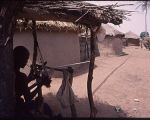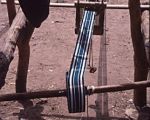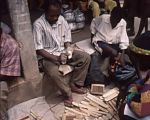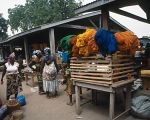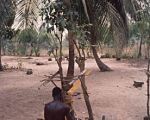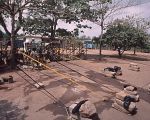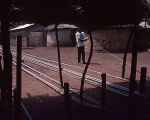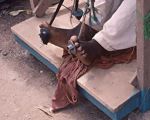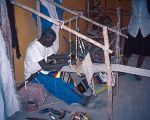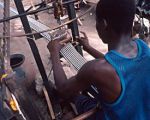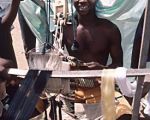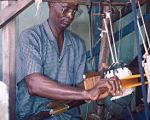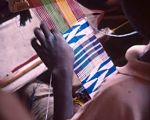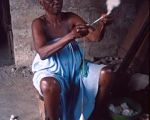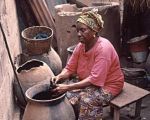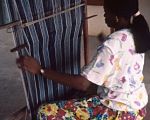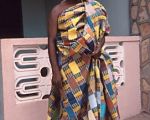Anansi's Gift of the Magic Thread
Estelle Carlson is a dyer and handweaver who creates beautiful garments with fabrics from around the world. In this article she tells of her encounters with some Kente weavers in Ghana.
Earlier this year I traveled to Ghana and Togo--two countries in West Africa. While visiting these countries I met many weavers, dyers and spinners. One of the outstanding weavers I met was a gentleman who lives in the Ashante town of Bonwire. His name is Samuel Cophie. I spent the day with Mr. Cophie and had time to not only observe his students weave their narrow strips of vividly colored cloth--but to meet with his wives and children. I asked Mr. Cophie many questions about weaving techniques, the strip-weaving looms, and his students--even about how he became a weaver. I then asked how strip weaving originated in West Africa. "Tradition" was his initial answer--but within time he also told me about Anansi, the spider--a popular folk hero in Ashante folklore.
Hundreds of years ago rainforests covered the land that today is known as Ghana. It is in this rainforest that the Ashante people live--and it is also in this rainforest that Anansi, the spider lives. Now, Anansi a wise and lovable trickster is shrewd and cunning. He is a troublemaker, but he is also imaginative and creative.
One day during the reign of Oti Akenten (about 1600 AD) two brothers--Nana Kragu and Nana Ameyaw--went hunting in the rain forest. After searching all day for food with no success they finally spotted a herd of impala. They were delighted with their find, but on closer inspection the brothers spied something else--something that hovered near this herd. What was this thing that glistened with the evening mist and reflected the colors of the rainbow? And who was this creature that was sitting in the very center of this delicate object? "I am a spider--I am Anansi, the spider and this "object" is a web," was the reply. "And in return for several favors I will teach you how to weave lovely webs like this."The brothers accomplished the tasks Anansi gave them and in return they learned the art not only of weaving but the arts of spinning and dyeing. Upon returning to the village, the brothers showed everyone the beautiful fabric they had woven. They told everyone about the looms they had built and the threads they had spun and dyed. And, of course, they told everyone about Anansi's gift---the Gift of the Magic Thread.
The loom Anansi constructed for the brothers was the simplest of looms--a loom built out of tree limbs and branches. This simple, portable loom is still in use today and can be seen all over West Africa. It is known as a strip-weaving loom.Four sturdy tree limbs buried in the ground establish the frame for this loom. Its harnesses and beaters are supported by an overhead limb or by a beam in a roof. The front warp beam is also a strong tree limb that is tied to support branches with twine--it is this limb that carries the woven fabric.
The reed, shuttles, heddle pulleys are either constructed by the weaver or purchased in the market.
There is no warp beam on the back of the West African strip looms--only what is called by Eric Broudy (The Book of Looms) a "diverting bar". The warp travels over the diverting bar and stretches its full length across the compound's courtyard. The warp is then tied to a weight or stone--this weight both anchors the warp and maintains even tension. This weight is called a "drag Stone". As the weavers weave and pull the warp forward the stone is dragged along the dirt towards the weaver. In many villages you can see the path the stone makes as it is dragged closer and closer to the loom.
The warp is prepared either in the courtyard of the compound, out in the streets of the village or any place where there is enough space. If space is a problem--as in some towns in Mali, the professional Warp Preparer will wind the warp around his house. However, when there is enough space poles three feet in height are used. They are hammered in the dirt and spread evenly apart. A forked tree branch is sometimes used to maintain the cross. For an Ashante man's cloth (or toga) which is usually 24 strips wide and approximately 3 yards long, the warp has to be 32 yards long. The warp poles are arranged in any manner that is convenient to obtain this warp length. The Warp Preparer--which is an occupation akin to that of the weaver--knows from memory the required length and color rotation for a specified pattern.After the warp is prepared, it is wrapped onto large bobbins, which are then placed on the tines of a bobbin carrier. This bobbin carrier is called in Ashante "menokomenam", which means "I walk alone". From the bobbin carrier the warp is transferred to the shuttles.
Treadles are also simple in construction. Twine is tied to the harnesses--at the end of the twine are knobs which are made from a calabash gourd. These knobs are placed between the toes of the weaver. As the weaver's feet move up and down so do the harnesses. In Mali a knot is made at the end of the twine and this knot is placed between the weaver's toes. In both instances the function is the same--the weaver's feet become the treadles.Weaving is done outside and is a social activity. Small sheds or fronded roofs are built to protect the weavers from the heat of the sun. Shade from trees also can protect the weaver from the mid-day heat. As I wandered through a village I would see weavers working together with their long warps stretching far into the compound. Up to three yards of woven fabric is made during one day's weaving. At the end of the day the weaver dismantles his loom and takes it inside the house for the evening.
A weaver I met in Timbuktu (Mali) demonstrated for me the ease of dismantling a loom. He was weaving in a guildhall in the city of Timbuktu. I arranged to meet with him at the end of the day--he wanted me to meet and have dinner with his family. He took his warp, the reed and woven fabric, wrapped them into a ball and placed them into a bag. He then untied and collapsed his loom, bound the loom pieces together, put the loom on his head and shoulders and carried it home.
The specific looms used by Samuel Cophie (and other Kente cloth weavers) are both similar and different from the simple West African strip loom. The looms are similar in terms of treadles and the extension of the warp into the compound--but this loom is not created from the limbs and branches of trees. These looms are the result of expert carpentry work. They are set upon a platform, with the upper beams being notched or serrated--these notched beams support the heddles and the beater and give the weaver greater flexibility.
The Ashante weavers often use two pairs (sometimes three) pairs of heddles--this enables the weaver to alter the colors within the warp and is called "double weave" by the Ashante and Ewe weavers (this "double weave" differs from the western "double weave"). The first pair of heddles weave what is called the "asatia" (tabby)--the remaining heddles control the threads which weave the pattern. Weavers that do not use these extra heddles use the pick-up method for patterning.
The drag stone for the Ashante loom is placed on rollers. The warp is knotted and tied to the rocks or bricks with a clip or stick. In my observations this particular loom is used primarily by the Ashante weavers in the Kumasi area of Ghana (west central Ghana) and the Ewe weavers in the Southeastern part of Ghana. In the other areas of West Africa that I have visited the simpler loom is used.
As simple as these looms are they command great respect from the West African weaver. The weaver not only has to be able to construct his own loom--he also has to care for it. Old looms can not be broken up for firewood or used for any purpose other than weaving. The entire loom if it is no longer in use has to be thrown into the river. The loom according to Eric Broudy is "regarded as a household deity, a protector of the home". If any criminal or adulterous act is committed with the weaver's home a sheep has to be sacrificed to the loom and to the Chair of the ancestors.
Weaving on these narrow strips looms is a man's activity. The art of weaving is taught to young boys at a very early age--somewhere between five and six. These young boys are taught initially how to wind skeins, load shuttles and thread the reed and heddles--the latter job is not easy task. As he grows he is taught how to weave plain weaves, stripes and simple patterns. To weave the complex Kente or Ewe patterns he must be a skilled and practiced weaver.Through tradition and a variety of taboos women do not weave--although I have seen photographs of several women weaving Kente cloth and Mr. Cophie said there is one woman weaver in Bonwire. However, throughout West Africa women are traditionally excluded from strip weaving. Women are in some areas even excluded from the environs of the loom. Captain R. S. Rattry in his book Ashante stated that in the Ashante culture "women could never be weavers owning to the fact that they have menstrual periods...a woman during her periods may not touch a loom. A woman in this condition must not even address her husband directly". It is also generally believed that the women who do weave Kente cloth will become infertile.
According to Anne Spencer (Wrapped in Pride) several organizations--The Centre for the Development of People, The Anglican Diocesan Mothers' Union and the Trinity Church I New York City--have all sponsored The Bonwire Anglican Women Kente Project and claim to have trained twenty women to weave. Another project in the 1980's near Agbozume also taught women to weave Kente (or Ewe) cloth, but this project was abandoned in the mid 1990's.
Women in West Africa do weave--however, they weave on looms other than the strip looms. In Togo and Cameroon women weave wider fabrics on the upright single heddle looms and in Nigeria women weave on horizontal single heddle looms. Women in many West African countries spin and dye yarns. They are also the primary sellers of woven cloth in the markets.
The importance of the role of weaving in West Africa cannot be overestimated. It has a role in all aspects of life--the domestic, social, commercial and religious
The European during the colonial period brought to West Africa the four harness loom and though this loom is in use (I saw one weaver using this loom in the Kumasi Cultural Center) it is disregarded by the vast majority of weavers in favor of the strip weaving loom. Cloth is imported and used by West Africans, but still it is the narrow strip weaving that provides employment for weavers across West Africa. Blankets, bags, sheets, rugs, tent dividers, pillows, umbrellas, shawls, head cloths, trousers, robes, smocks, etc... are just a few of the products produced by the strip weaver. Imported fabrics cannot replace the strength and durability of this fabric--nor the aesthetic.The history of the strip loom in West Africa has its origins in tradition and folklore. However, in all probability the loom came to West Africa via the trans-Saharan trade routes. The introduction of the strip loom along with the cultivation of cotton occurred sometime during the 11th century AD. The Ashante loom is said to have been brought from the Bondouku area in the Ivory Coast to Bonwire by a man name Ota Kraban sometime in 1600 AD. He brought the loom on a Friday--hence the name of the loom "nasdua kofi"--or "loom Friday"--(Wrapped in Pride--Doran H. Ross).
No one truly knows how or when weaving came to this area of the world--and until historians and scientists can provide a definitive answer we can all be charmed with the story of Anansi, the spider. We along with the Ashante and all West African weavers can believe that it was this folk hero who gave the weavers the Gift of the Magic Thread.
Bibliography
Adler, Peter and Nicholas Barnard: African Majesty, the Textile Art of The Ashante and Ewe Thames and Hudson, Ltd., London--1992
Ahiagble, Gilbert and Louise Meyer: Master Weaver from Ghana Open Hand Publishing, Seattle, Washington 1998
Broudy, Eric: The Book of Looms Brown University Press, London 1979
Lamb, Venice: West African Weaving Duckworth and Co., Ltd., London--1975
Ross, Doran: Wrapped in Pride, Ghanaian Kente and African American Identity UCLA Fowler Museum of Cultural History and the Newark Museum--1998
Schaedler, Karl-Ferdinand: Weaving in Africa, South of the Sahara Panterra- Verlag, Druckhaus Munchen, West Germany--1987
Photo Credits:
all photographs by Estelle Carlson

